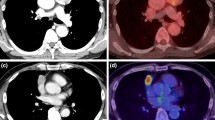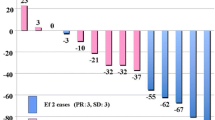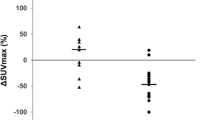Abstract
Background
The resectability and survival may be improved in thymoma and thymic carcinoma with multimodality therapy. Various diagnostic imaging modalities are required for accurate diagnosis and preoperative staging of thymic masses. The present prospective study was planned to evaluate if Fluorodeoxyglucose (FDG) PET-CT can help differentiate various thymic lesions noted on conventional imaging modalities.
Methods
A prospective study was undertaken in 23 patients who had shown either an anterior mediastinal mass consistent with thymic origin or suspicious for a thymic mass on contrast-enhanced computed tomography scan. All patients underwent whole body FDG PET-CT after intravenous injection of 370 MBq of FDG. The interpretation of PET-CT images was based on the following criteria: FDG uptake (present or absent), SUVmax, pattern of uptake, invasion to surrounding structures, presence of metastasis and necrosis. The results of PET-CT were correlated with the final histopathology following surgery. Statistical analysis was performed with SPSS 11.5 for Windows software. The mean SUVmax of the 3 groups of pathology was compared using the Kruskal–Wallis Test.
Results
Thymic hyperplasia had an enlarged thymus with mean SUVmax of 1.1. Low risk thymoma had large tumors and their mean SUVmax was 3. High risk thymoma had small tumors with mean SUVmax of 2.1. As a group, thymoma had mean SUVmax value of 2.3. All thymic carcinomas were large, and their mean SUVmax was 7. The difference between the mean SUVmax for thymic hyperplasia, thymoma and thymic carcinoma was statistically significant. The difference between the SUVmax of high risk and low risk thymoma was not significant.
Conclusion
18F-FDG PET-CT can help characterize various thymic lesions noted on conventional imaging modalities. However, larger prospective studies are further required to substantiate these findings.





Similar content being viewed by others
Abbreviations
- PET-CT:
-
Positron emission tomography computed tomography
- FDG:
-
Fluorodeoxyglucose
- SUVmax:
-
Maximum standardized uptake value
- FWHM:
-
Full-width half maximum
- MBq:
-
Mega Becquerel
- VATS:
-
Video-assisted thoracoscopic surgery
References
Masaoka A, Monden Y, Nakahara K, Tanioka T. Follow-up study of thymomas with special reference to their clinical stages. Cancer. 1981;48(11):2485–92.
Detterbeck FC, Parsons AM. Thymic tumors. Ann Thorac Surg. 2004;77:1860–9.
Nakahara K, Ohno K, Hashimoto J, Maeda H, Miyoshi S, Sakurai M, et al. Thymoma: results with complete resection and adjuvant postoperative irradiation in 141 consecutive patients. J Thorac Cardiovasc Surg. 1988;95(6):1041–7.
Curran WJ Jr, Kornstein MJ, Brooks JJ, Turrisi AT 3rd. Invasive thymoma: the role of mediastinal irradiation following complete or incomplete surgical resection. J Clin Oncol. 1988;6:1722–7.
Restrepo CS, Pandit M, Rojas IC, Villamil MA, Gordillo H, Lemos D, et al. Imaging findings of expansile lesions of the thymus. Curr Probl Diagn Radiol. 2005;34(1):22–34.
de Kraker M, Kluin J, Renken N, Maat APWM, Bogers AJJC. CT and myasthenia gravis: correlation between mediastinal imaging and histopathological findings. Interact CardioVasc Thorac Surg. 2005;4:267–71.
Jeong YJ, Lee KS, Kim J, Shim YM, Han J, Kwon OJ. Does CT of thymic epithelial tumors enable us to differentiate histologic subtypes and predict prognosis? Am J Roentgenol. 2004;183:283–9.
Inaoka T, Takahashi K, Mineta M, Yamada T, Shuke N, Okizaki A, et al. Thymic hyperplasia and thymus gland tumors: differentiation with chemical shift MR imaging. Radiology. 2007;243:869–76.
McGowan KM, Long SD, Pekala PH. Glucose transporter gene expression: regulation of transcription and mRNA stability. Pharmacol Ther. 1995;66(3):465–505.
Wahl RL. Targeting glucose transporters for tumor imaging: “sweet” idea, “sour” result. J Nucl Med. 1996;37(6):1031–7.
Liu RS, Yeh SH, Huang MH, Wang LS, Chu LS, Chang CP, et al. Use of fluorine-18 fluorodeoxyglucose positron emission tomography in the detection of thymoma: a preliminary report. Eur J Nucl Med. 1995;22(12):1402–7.
Kubota K, Yamada S, Kondo T, Yamada K, Fukuda H, Fujiwara T, et al. PET imaging of primary mediastinal tumours. Br J Cancer. 1996;73(7):882–6.
Sasaki M, Kuwabara Y, Ichiya Y, Akashi Y, Yoshida T, Nakagawa M, et al. Differential diagnosis of thymic tumors using a combination of 11C-methionine PET and FDG PET. J Nucl Med. 1999;40(10):1595–601.
Ohtsuka T, Nomori H, Watanabe K, Naruke T, Suemasu K, Kosaka N, et al. Positive imaging of thymoma by 11C-acetate positron emission tomography. Ann Thorac Surg. 2006;81:1132–4.
Sung YM, Lee KS, Kim BT, Choi JY, Shim YM, Yi CA. 18F-FDG PET/CT of thymic epithelial tumors: usefulness for distinguishing and staging tumor subgroups. J Nucl Med. 2006;47:1628–34.
El-Bawab H, Al-Sugair AA, Rafay M, Hajjar W, Mahdy M, Al-Kattan K. Role of fluorine-18 fluorodeoxyglucose positron emission tomography in thymic pathology. Eur J Cardiothorac Surg. 2007;31:731–6.
Endo M, Nakagawa K, Ohde Y, Okumura T, Kondo H, Igawa S, et al. Utility of 18FDG-PET for differentiating the grade of malignancy in thymic epithelial tumors. Lung Cancer. 2008;61(3):350–5.
Detterbeck FC. Clinical value of the WHO classification system of thymoma. Ann Thorac Surg. 2006;81:2328–34.
Meltzer CC, Leal JP, Mayberg HS, Wagner HN Jr, Frost JJ. Correction of PET data for partial volume effects in human cerebral cortex by MR imaging. J Comput Assist Tomogr. 1990;14(4):561–70.
Chen CH, Muzic RF Jr, Nelson AD, Adler LP. Simultaneous recovery of size and radioactivity concentration of small spheroids with PET data. J Nucl Med. 1999;40(1):118–30.
Rousset OG, Ma Y, Evans AC. Correction for partial volume effects in PET: principle and validation. J Nucl Med. 1998;39(5):904–11.
Kumar R, Chauhan A, Zhuang H, Chandra P, Schnall M, Alavi A. Clinicopathologic factors associated with false negative FDG-PET in primary breast cancer. Breast Cancer Res Treat. 2006;98(3):267–74.
Acknowledgments
This project was supported by All India Institute of Medical Sciences, New Delhi, India.
Author information
Authors and Affiliations
Corresponding author
Rights and permissions
About this article
Cite this article
Kumar, A., Regmi, S.K., Dutta, R. et al. Characterization of thymic masses using 18F-FDG PET-CT. Ann Nucl Med 23, 569–577 (2009). https://doi.org/10.1007/s12149-009-0283-z
Received:
Accepted:
Published:
Issue Date:
DOI: https://doi.org/10.1007/s12149-009-0283-z




